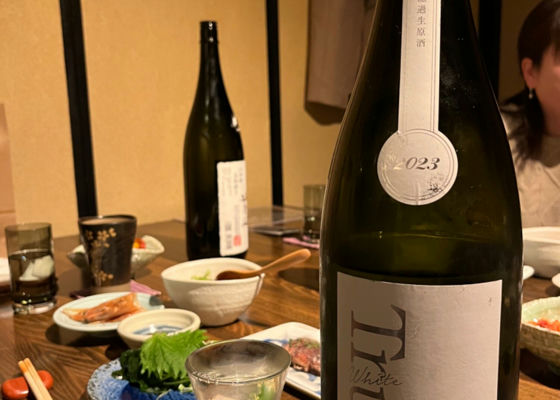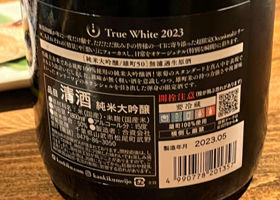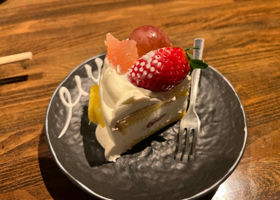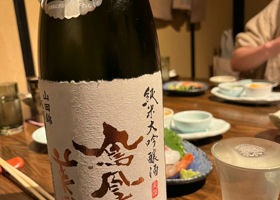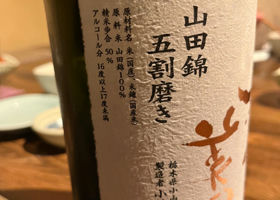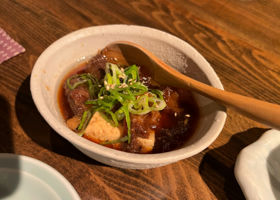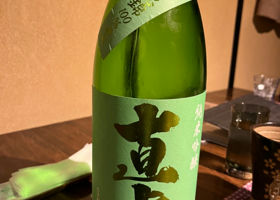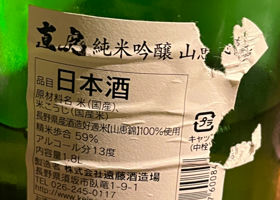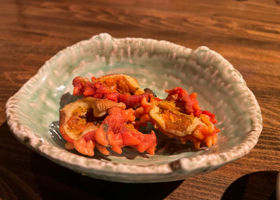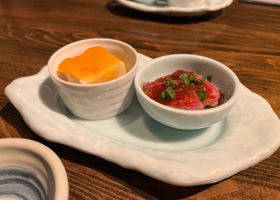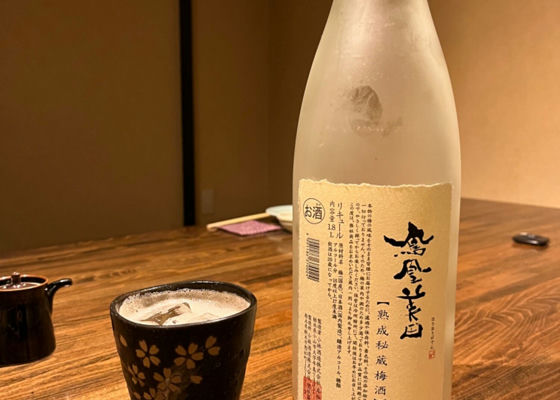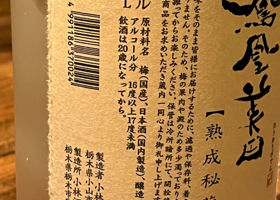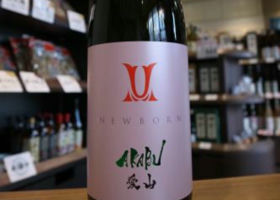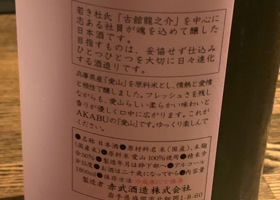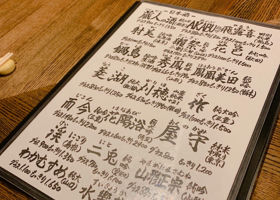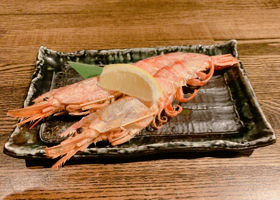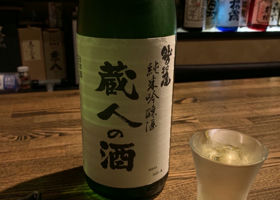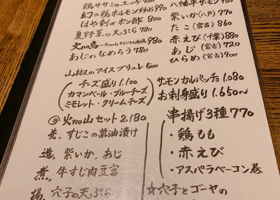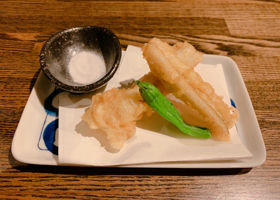Timeline
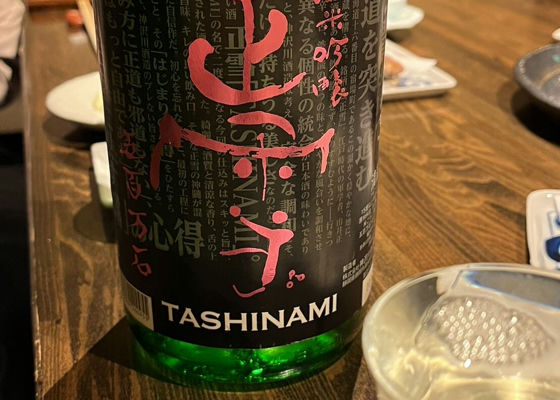
しんしんSYE and A asked for this.
It's winter, so it's snow season: ⛄️
They were attracted by the brand name and ordered it, but apparently they didn't like it so much!
So, half of the half glass was given to me by Mr. E and 2/3 of the glass by Mr. A. I drank it!
I wasn't so bad at it, so I drank a lot of it!
Thank you very much for your kindness 🍶.
extensive knowledge
Junmai Ginjo Gohyakumangoku started as Shoyuki Challenge Series. Now it is shipped as TASHINAMI as a summer limited edition sake. It is a crisp, dry sake for summer, and the concept is "Hatsui (Ui) Ai (Ui) Sake" with the hope that people will "easily pick it up and love it. The yeast used, "NEW-5," is one of the Shizuoka yeast strains, and has a light flavor with a moderate aroma, making it a refined and easy-to-drink sake with a refreshing mouthfeel and a delicious rice flavor.
The label is an Evangelion-style label with a string of intersecting characters that expresses the brewing of this year's sake and our feelings about sake.
Rice used: Gohyakumangoku (produced in Toyama)
Rice polishing ratio: 50
Yeast used: Shizuoka NEW-5
Sake meter rating: +4.6
Acidity: 1.0
Alcohol percentage: 15.8 しんしんSYWe continued to drink!
We were so tipsy that two of them asked us to try this one too!
We finished with "Kangiku" just like Mr. K!
Delicious!
But when I paid the bill later and looked at the receipt, I found that the price was quite expensive!
Well, I wish they would have included it in the all-you-can-drink plan at NONO-IE, TRUE!
I ate the cake that Mr. A chose for me and I am full 🫃.
I appreciate the manager's thoughtfulness in serving the cake 🍰.
Let's close the first meeting around here!
knowledge
The name of the white chrysanthemum is related to the word "truth" in the language of flowers. Focusing on "scenes" and "feelings," it colors everyday life with an occassional (special moment) from a different perspective from the four seasons.
Sake degree: -4
Acidity: 1.5
Alcohol percentage: 15
Rice: Omachi 50% polished rice しんしんSYWe had Houou Mita for the Umeshu, so let's have Houou Mita for the sake next!
It is my favorite brand!
We had a light course menu except for the crab pizza, but it was quite hearty!
I forgot to take a picture of grilled dish and sashimi!
We chatted a lot and drank a lot, but we were too lazy to finish our dishes!
I have to eat soon!
The manager kindly allowed the four of us to enjoy our drinks since there were only a few bottles left 😋.
(the manager's) extensive knowledge of Japanese cuisine
Rice used: Yamadanishiki
Polishing ratio 50%.
Specified name sake, etc. Junmai Daiginjo/namaishu
15% alcohol by volume しんしんSYAfter finishing the Umeshu (plum wine), we all gathered together.
They asked which sake we would like to start with.
I was going to start with Houou Mita, but since Naotora was the first sake for both of them, I followed their lead and joined them!
Oh, it's delicious!
What's this?
I'll keep that in mind, memo memo memo!
Hoya goes well with sake, doesn't it?
knowledge
Method of preparation Junmai Ginjo
Alcohol content 13
Sake degree -6
Acidity 1.5
Ingredient rice: 100% Yamae-Nishiki from Nagano Prefecture
Polishing ratio 59
Ingredients: Rice (Yamae-Nishiki), Rice Koji (Yamae-Nishiki) しんしんSYAttending a night party in Morioka
Until we all get together, we'll start with a plum wine that I'm a little curious about: ▶️
It's Houou Mita!
We quenched our thirst with soda.
Looking forward to the sake 😊.
Crab pizza 🍕!
a lot of knowledge
This secret plum wine is made by marinating premium Miyano-Ume plums from Tochigi prefecture in Hououmida's Ginjo-shu. えりりんThank you for hosting my birthday party despite your busy schedule😊.
The Aragoshi Umeshu was delicious 😋. しんしんSYCongratulations to Eririn: ㊗️
It was a fun event with Mr. K and Ms. A gathering together as they did last year.
I heard that you drank Sakura Sakura Nigori-gori (cherry blossom nigori-gori) right after the event. Another excellent product, please use it 🍶. しんしんSYSorry, the picture was blurry.
I took it so you could see.
Junmai Ginjo, a quintessential taste!
extensive knowledge
Akabu no Aizan, which started in 29BY and has become very popular, is now in stock.
The top aroma is relatively mild, but mellow and luscious, like strawberry or delicate apple.
The aroma is typical of Aizan. When you drink it, it is full-bodied and sweet, and the aftertaste is also fresh and lush, typical of Akabu.
This is a bottle that will attract not only Akabu fans and Aizan fans, but also many other drinkers!
Rice used: Aiyama Polishing: 50%.
In case you are wondering, today's 1 fruity しんしんSYThe third cup
Wasinoo
Junmai Ginjo Sake
Sweet taste, fruity
It was during Japan's post-war period of rapid economic growth that changes began to appear in the way brewers worked, which had continued for many years.
Year-round employment became the norm, migrant workers were shunned, and the wave of mechanization swept through the breweries.
These changes in society brought a sense of crisis to many breweries, as they realized that they would not be able to continue brewing sake in their traditional style. Gekkeikan, for example, introduced a four-season brewing system in 1961, using employees hired on a yearly basis, marking a major turning point in its sake brewing system.
Goes well with snacks RecommendedContentsSectionView.title

